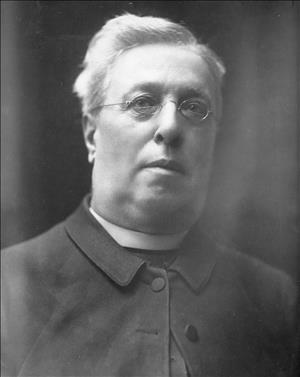Father Francis Xavier Prefontaine was pioneer Seattle's first resident priest. He arrived in 1867 after a stint in Port Townsend, and built Seattle's first Roman Catholic church, Our Lady of Good Help, on 3rd Avenue and Washington Street.
Born in 1838 in Longuiel, Quebec, Francis Xavier Prefontaine attended parochial schools and Nicolet College, then entered the Grand Seminary at Montreal. Within three weeks of his ordination he left for Puget Sound and the Diocese of Nisqually. Fr. Prefontaine never returned to his native Quebec.
Quebec, in the mid-1800s, relentlessly dispatched bright, dedicated young priests to the wet verdancy of Oregon Territory. The most famous of these missionaries were the brothers Blanchet, A.M.A. Blanchet of Nisqually, and Archbishop F. N. Blanchet of Oregon. Another well-known Quebecois was Modeste Demers who became Bishop of Vancouver Island. These men were aided in their work by John McLoughlin, Chief Factor for the Hudson's Bay Company at Fort Vancouver, who had embraced the Roman Catholic faith in his later years.
Fr. Prefontaine entered his religious vocation as a secular or diocesan priest, which meant that he did not take vows of poverty. However he promised celibacy to his supervising bishop, and all his orders came from that authority.
During a brief stay in Portland, Oregon, Prefontaine studied English and the Chinook trade jargon. His first assignment was to minister to Indians and whites at Fort Stevens, near the mouth of the Columbia River. Losing his way in the dark and rain, he awoke on a foggy morning to find a dead Indian next to him, and the hammocks of other cemetery inhabitants hanging overhead.
Prefontaine's next assignment was to assist in saying Mass for nuns and parishioners near Steilacoom, Washington. He was also asked to give instruction to local Catholic children and supervise the building of several chapels in the area. It may have been at Steilacoom that he met Mother Joseph, or Esther Pariseau, of the Sisters of Providence, who had been sent from Vancouver to help design and build a school.
By 1865, it was clear that Tacoma and points north would dominate the commerce of Puget Sound. Steilacoom had become a scenic backwater. Blanchet wrote to Prefontaine describing the division of the Sound district into two missions. Prefontaine was given the northern jurisdiction, and he chose the only town that had a Catholic church, Port Townsend. Visiting clerics came and went, but no resident pastor had been found. Prefontaine eventually petitioned Blanchet for a transfer to Seattle.
In October 1867, after promising the bishop to look after his northern Puget Sound settlements, 29-year-old Fr. Prefontaine came ashore at the busy downtown of what is today's Pioneer Place. Seattle had 600 residents in 1867, of whom 10 were reported as Catholics. Missionaries of several denominations had set up tents in Seattle, often enroute to more remote communities, but Seattle was really a lumber mill town -- Yesler's Mill -- which just 11 years before had fought off an Indian attack. It was also a bachelor town, bent on work and play.
Prefontaine rented a little two-room house on 3rd Avenue near Yesler Way. He converted the larger room into a church, and the other room served as his residence. In that little chapel, on November 24, 1867, he said mass for a congregation of two women.
The young secular priest enlarged his real estate holdings (he owned two lots in Port Townsend) and began to clear land in downtown Seattle on what is today Prefontaine Place S. A creek bubbled through that small canyon, and its banks held great trees -- one was eight feet thick. Henry Yesler claimed later that he supplied the lumber for Seattle's first Catholic church, Our Lady of Good Help, on the corner of 3rd Avenue and Washington Street. The new church was dedicated in the fall of 1870.
Prefontaine's secular status allowed him to accumulate property. His niece once noted that he had a "sound head for business" and "expensive tastes." At his death he left an estate of $33,173 (a large sum in 1909). A soap factory he bought in 1877 became part of the site of the Sisters of Providence first hospital at 5th Avenue and Madison Street. The Sisters of Holy Names established their first Seattle school on two Prefontaine lots at 2nd Avenue and Seneca Street.
By 1883, the Catholic church at 3rd Avenue and Washington Street was well established with a congregation of 600.
By 1900, Fr. Prefontaine's health began to decline, and in 1901 his 18-year-old niece Marie Rose Pauze came to look after him. His interests became more secular: a taste for good whiskey, the enjoyment of large cigars, reading from his extensive library, and the purchase of a fine three-story home overlooking Volunteer Park on Capitol Hill. In 1905, a new Church of Our Lady of Good Help was constructed, but Francis Prefontaine played no further role in the life of his pioneer parish.
But he received honors. Seattle Mayor R. A. Ballinger and members of the City Council proposed to name the block from 3rd Avenue and Yesler Way to 4th Avenue and Washington Street "Prefontaine Place." Prefontaine was also honored by Pope Pius X and made a member of the papal household, or Monsignor.
Upon his death in 1909 at the age of 70, Fr. Prefontaine's estate left a bequest of $5,000 for the construction of a public fountain, "if possible, in the immediate vicinity of Prefontaine Place." The fountain was built and remains today at the little triangle on 3rd Avenue and Yesler Way.
Father Prefontaine once told a dying Seattle prostitute that her Skid Road profession was only a fraction of her life, with "the Man at the Gate" knowing her entire story.
Prefontaine's life is a small slice of Seattle history, but an influential part of the city's pioneer heritage.

